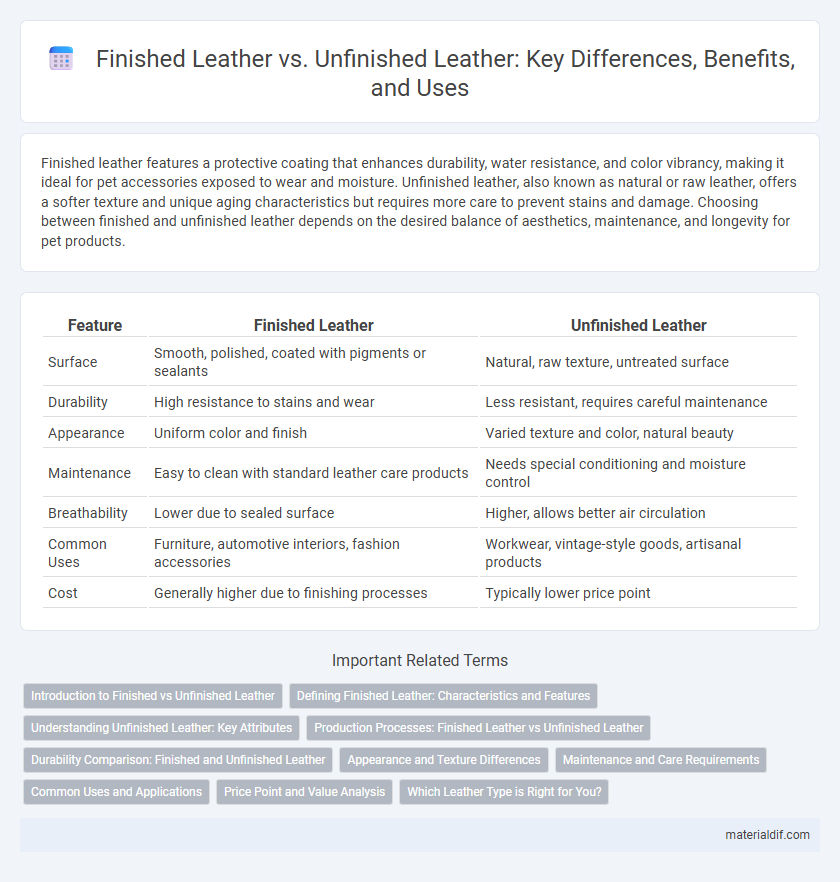Finished leather features a protective coating that enhances durability, water resistance, and color vibrancy, making it ideal for pet accessories exposed to wear and moisture. Unfinished leather, also known as natural or raw leather, offers a softer texture and unique aging characteristics but requires more care to prevent stains and damage. Choosing between finished and unfinished leather depends on the desired balance of aesthetics, maintenance, and longevity for pet products.
Table of Comparison
| Feature | Finished Leather | Unfinished Leather |
|---|---|---|
| Surface | Smooth, polished, coated with pigments or sealants | Natural, raw texture, untreated surface |
| Durability | High resistance to stains and wear | Less resistant, requires careful maintenance |
| Appearance | Uniform color and finish | Varied texture and color, natural beauty |
| Maintenance | Easy to clean with standard leather care products | Needs special conditioning and moisture control |
| Breathability | Lower due to sealed surface | Higher, allows better air circulation |
| Common Uses | Furniture, automotive interiors, fashion accessories | Workwear, vintage-style goods, artisanal products |
| Cost | Generally higher due to finishing processes | Typically lower price point |
Introduction to Finished vs Unfinished Leather
Finished leather undergoes treatments like dyeing, coating, and embossing to enhance durability, appearance, and resistance to water and stains, making it ideal for high-use products such as upholstery and footwear. Unfinished leather, also known as natural or raw leather, retains its natural surface without surface coatings, offering a softer feel and unique patina that develops over time but requires more maintenance. Choosing between finished and unfinished leather depends on desired aesthetics, durability needs, and willingness to perform ongoing care.
Defining Finished Leather: Characteristics and Features
Finished leather exhibits a smooth, polished surface achieved through extensive treatments such as dyeing, coating, and embossing, enhancing durability and aesthetic appeal. It features a protective layer that resists stains, moisture, and wear, making it ideal for upholstery, footwear, and fashion accessories. The uniform color and texture resulting from finishing processes distinguish finished leather from unfinished leather, which retains its natural, raw characteristics.
Understanding Unfinished Leather: Key Attributes
Unfinished leather retains its natural surface, displaying unique textures and markings that highlight its raw, authentic character. It lacks surface coatings or treatments, resulting in a breathable material that develops a rich patina over time. This type of leather is highly valued for its durability and ability to age gracefully, offering a distinctive aesthetic unmatched by finished leather.
Production Processes: Finished Leather vs Unfinished Leather
Finished leather undergoes extensive treatment processes such as dyeing, polishing, and coating to enhance its appearance, durability, and water resistance, resulting in a smooth and uniform surface. Unfinished leather retains its natural texture and appearance with minimal processing, typically only tanned to prevent decay without additional surface treatments. The production of finished leather involves multiple stages including buffing, staining, and the application of protective topcoats, whereas unfinished leather requires simpler tanning and drying methods, preserving its raw and breathable qualities.
Durability Comparison: Finished and Unfinished Leather
Finished leather features a protective coating that enhances resistance to water, stains, and scratches, significantly improving its durability in everyday use. Unfinished leather, lacking this protective layer, is more susceptible to wear, developing a natural patina that reflects aging but requires more maintenance to prevent damage. The choice between finished and unfinished leather depends on the desired balance between durability and natural appearance.
Appearance and Texture Differences
Finished leather features a smooth, uniform surface with added coatings that enhance color vibrancy and provide a glossy or matte finish, making it more resistant to water and stains. Unfinished leather retains its natural texture, showing visible grain, pores, and imperfections that contribute to a unique, rustic look and a softer, more pliable feel. The absence of surface treatments in unfinished leather allows it to develop a rich patina over time, whereas finished leather maintains its initial appearance longer due to protective layers.
Maintenance and Care Requirements
Finished leather features a protective coating that resists stains and moisture, significantly reducing maintenance and making cleaning easier with just a damp cloth. Unfinished leather, also known as raw or natural leather, absorbs oils and moisture quickly, requiring regular conditioning and careful cleaning to prevent drying, cracking, and discoloration. Proper care for unfinished leather includes avoiding harsh chemicals and using specialized leather conditioners to maintain suppleness and durability.
Common Uses and Applications
Finished leather features a protective coating that enhances durability, water resistance, and aesthetic appeal, making it ideal for products like shoes, handbags, and upholstery. Unfinished leather retains its natural texture and breathability, favored for high-end fashion items, custom leather goods, and artisanal crafts where softness and natural aging are desired. Both types serve distinct purposes: finished leather excels in durability and uniformity, while unfinished leather prioritizes natural character and flexibility.
Price Point and Value Analysis
Finished leather typically commands a higher price point due to its enhanced durability, uniform appearance, and protective coatings that increase resistance to stains and wear. Unfinished leather, while more affordable and prized for its natural texture and ability to develop a unique patina over time, requires more maintenance and is less resistant to damage. The value analysis favors finished leather for long-term durability and low upkeep, whereas unfinished leather appeals to consumers prioritizing authenticity and cost savings.
Which Leather Type is Right for You?
Finished leather offers a smooth, protective coating that enhances durability and stain resistance, making it ideal for items requiring easy maintenance like jackets, bags, and furniture. Unfinished leather, or natural leather, maintains its raw texture and breathability, appealing to those who value a more authentic, rugged appearance that develops character with age. Your choice depends on whether you prioritize durability and low maintenance or a natural, evolving aesthetic.
Finished Leather vs Unfinished Leather Infographic

 materialdif.com
materialdif.com